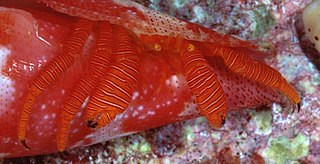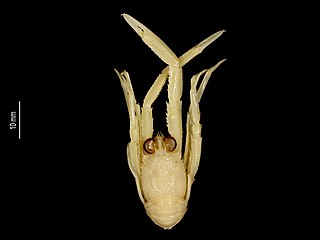
The halloween hermit crab, also known as the striped hermit crab or orange-legged hermit crab, is a brightly colored aquatic hermit crab of the family Diogenidae. Besides its ability to routinely clean algae in aquaria, the halloween hermit crab's festive striped coloration also appeals to enthusiasts; it is considered the most brightly colored hermit crab in normal aquarium use.

Portunidae is a family of crabs which contains the swimming crabs. Its members include many well-known shoreline crabs, such as the blue crab and velvet crab. Two genera in the family are contrastingly named Scylla and Charybdis; the former contains the economically important species black crab and Scylla paramamosain.

The Diogenidae are a family of hermit crabs, sometimes known as "left-handed hermit crabs" because in contrast to most other hermit crabs, its left chela (claw) is enlarged instead of the right. It comprises 429 extant species, and a further 46 extinct species, making it the second-largest family of marine hermit crabs, after the Paguridae.

The Galatheidae are a family of squat lobsters.

Albuneidae is a little-known family of specialized burrowing sand crabs. There are 50 extant species as well as nine fossil species that have been described. Fossil specimens have been described from the Cretaceous, Miocene and Oligocene.

Corystidae is a family of crabs, in its own superfamily, Corystoidea. It includes what was once thought to be the oldest Eubrachyuran fossil, Hebertides jurassica, thought to be dating from the Bathonian ; the species was subsequently reinterpreted as being Cenozoic in age. Corystidae contains ten extant and five extinct species in eight genera:

Diogenes is a genus of hermit crabs.

Dardanus pedunculatus, commonly referred to as the anemone hermit crab, is a species of hermit crab from the Indo-Pacific region. It lives at depths of up to 27 m and collects sea anemones to place on its shell for defence.

Clibanarius fonticola is a species of hermit crab from Vanuatu. It lives exclusively in fresh water, the only hermit crab in the world to do so. While a number of other hermit crabs are terrestrial or live in estuarine habitats, and certain brackish water species can tolerate low salinity levels for a time, no other hermit crab spends its entire life in fresh water; the only other fully freshwater anomurans are the South American aeglids.

Ciliopagurus is a genus of hermit crabs, of the family Diogenidae, which are sometimes referred to as the "left-handed hermit crabs", because in contrast to most other hermit crabs, the left chela (claw) is enlarged instead of the right. They are found in the Indo-Pacific region and in the eastern Atlantic Ocean.
Ciliopagurus liui is a species of hermit crab native to the Gulf of Tonkin and waters to the south of Japan.
Ciliopagurus tricolor is a species of hermit crab native to Madagascar. It is one of four species in the "strigatus complex", having morphological similarities to C. strigatus, with the most prominent variance being coloration.

Ciliopagurus galzini is a species of hermit crab. It is one of four species in the "strigatus complex"; it resembles C. strigatus, with the most prominent difference being coloration. It is common in the shallow intertidal waters of the Tuamotus.
Ciliopagurus vakovako is a species of hermit crab native to the Marquesas Islands. It is typically found at a depth no lower than 57 metres (187 ft). C. vakovako appears to be a vicariant of C. strigatus, a species widespread throughout the Indo-pacific region.

Plesionida is a genus of squat lobsters in the family Munididae. As of 2017, it contains the following species:
Calcinus tubularis is a species of hermit crab. It is found in the Mediterranean Sea and around islands in the Atlantic Ocean, where it lives below the intertidal zone. Its carapace, eyestalks and claws are marked with numerous red spots. C. tubularis and its sister species, C. verrilli, are the only hermit crabs known to show sexual dimorphism in shell choice, with males using normal marine gastropod shells, while females use shells of gastropods in the family Vermetidae, which are attached to rocks or other hard substrates.

Diogenes heteropsammicola is a species of hermit crab discovered during samplings between 2012 and 2016 in the shallow waters of the Japanese Amami Islands. This D. heteropsammicola is strongly associated with the walking corals. This hermit crab species is unique due to the discovery that they use living, growing coral as a shell. They live in the inside of the coral and can be distinguished from other types of hermits by their thin chelipeds and leg shape. Crustaceans of this type commonly replace their shell as the organism grows in size, but D. heteropsammicola are the first of their kind to use solitary corals as a shell form. Heteropsammia and Heterocyathus are the two solitary corals that this hermit species has been observed as occupying. These two coral species are also used as a home by symbiotic Sipuncula of the genus Aspidosiphon, which normally occupy the corals that were previously occupied by crabs.

Calcinus morgani, commonly known as Morgan's hermit crab, is a species of hermit crab in the family Diogenidae found in the Indo-West Pacific region, the type locality being Indonesia.

The Ōshima Strait is a strait between the islands of Amami Ōshima and Kakeromajima in Japan. It is part of the Amami Guntō National Park. From the western most side to the eastern most side of the strait, the strait measures 17.5 miles (28.2 km) long.
Calcinus guamensis is a species of hermit crabs in the family Calcinidae.













